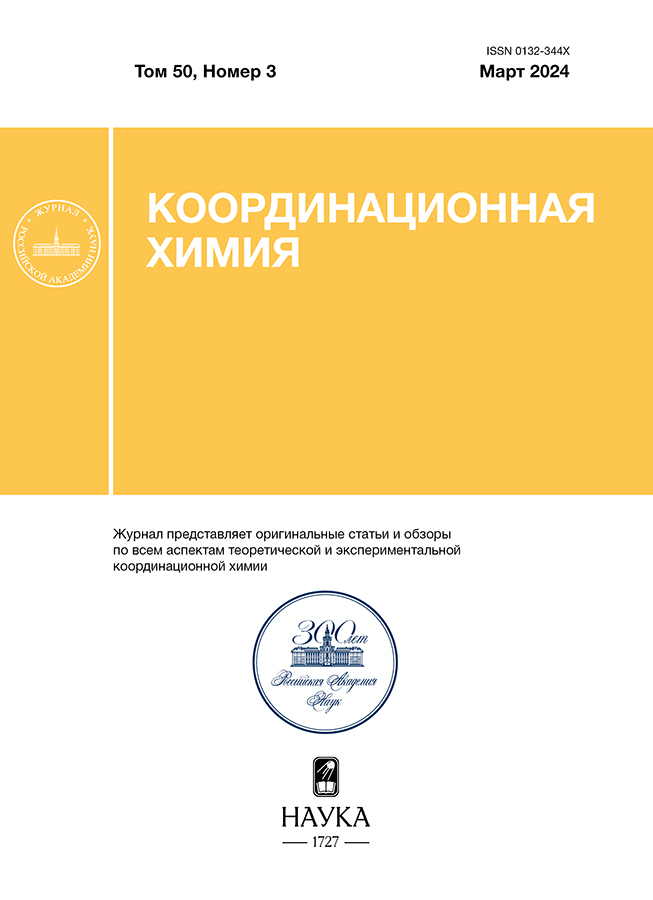Vol 50, No 3 (2024)
Articles
3D coordination polymers with N-heterocyclic Ga(I) moieties
Abstract
The reactions of bimetallic acenaphthene-1,2-diimine complex [(Dpp-bian-GaCr(CO)5]2- [Na(Thf)2]2 (I) (Dpp-bian = 1,2-bis[(2,6-diisopropylphenyl)imino]acenaphthene) with 4,4ʹ-bipyridine (4,4ʹ-Bipy) and 1,3-bis(4-pyridyl)propane (Bpp) in THF gave 3D coordination polymers [{(Dppbian) GaCr(CO)5}{Na(4,4ʹ-Bipy)3}]n (II) and [(Dpp-bian)GaCr(CO)4Na(Et2O)(Bpp)1,5]n (III), respectively. Compounds II and III were characterized by elemental analysis and NMR and IR spectroscopy. The molecular structure of II was established by X-ray diffraction (CCDC no. 2278024).
 149-162
149-162


Potassium, ytterbium(II), and samarium(III) alkoxide complexes containing the tris((2-dimethylaminomethyl)phenyl)methoxide ligand: synthesis and structures
Abstract
The reaction of tris((2-dimethylaminomethyl)phenyl)methanol ((2-Me2NCH2C6H4)3COH) with potassium hydride in THF at –35°C affords dimeric alkoxide {[(2-Me2NCH2C6H4)3CO]K(THF)}2 (I) in a yield of 90%. The reaction of compound I with YbI2(THF)2 (1 : 1, 25°C) gives the Yb(II) alkoxyiodide complex {[(2-Me2NCH2C6H4)3CO]Yb(μ-I)(THF)2}2 (II) in a yield of 57%. Complex II in the crystalline state is dimeric due to two bridging iodide ligands. Unlike the Yb(II) compound, the exchange reaction of complex I with SmI2(THF)2 (1 : 1, 25°C) in THF followed by the addition of dimethoxyethane (DME) involves the oxidation of the metal to form the trivalent samarium complex [(2-Me2NCH2C6H4)3CO]2SmI (III), which is isolated in a yield of 60%. The molecular structures of the complexes are determined by X-ray diffraction (XRD) (CIF files CCDC nos. 2259700 (I), 2259701 (II), and 2259702 (III)).
 163-173
163-173


Reactions of carbon dioxide bound to aluminum diimine hydride with borane dimethyl sulfide and ammonia
Abstract
The reaction of aluminum bis-formate acenaphthene-1,2-diimine complex [(ArBIG-bian)Al(μ-OC(H)O)2Li(Thf)2] (I) (ArBIG-bian = 1,2-bis[(2,6-dibenzhydryl-4-methylphenyl)imino]acenaphthene), prepared by binding carbon dioxide by aluminum diimine hydride [(ArBIG-bian)Al(H)2]–[Li(Thf)4]+, with borane dimethyl sulfide and ammonia was studied. The reaction of I with BH3∙SMe2 (1 : 1) in toluene affords the product of hydroboration of one formate group [(ArBIG-bian)Al(μ-OC(H)O)(OB(H)OCH3)Li(Thf)]2 (II), while the reaction of I with BH3∙SMe2 (1 : 2) is accompanied by reduction of both formate groups and gives complex [(ArBIG-bian)Al(OBOCH3)2OLi2(Thf)2BH4]2 (III), methoxyboroxine (CH3OBO)3 and, presumably, compound [(ArBIG-bian)AlOCH3]. The reaction of I with one equivalent of ammonia in THF gives adduct [(ArBIG-bian)Al(NH3)(μ-OC(H)O)2Li(Thf)2] (IV), in which ammonia is coordinated to the aluminum atom, while the key bonds in I have not undergone ammonolysis. Compounds II–IV were characterized by IR and NMR spectroscopy, elemental analysis, and X-ray diffraction (CCDC no. 2255017 (II), 2255018 (III), 2255019 (IV)).
 174-186
174-186


Lanthanide complexes of related click tripodal 1,2,3-triazole-containing ligands on the Ph3P(O) platform. The N2 and N3 coordination of triazole fragments
Abstract
The coordination and extraction properties of two related tripodal ligands differed by types of addition of the triazole fragment and linker length in the {2-[(4-Ph-1,2,3-triazol-1-yl)CH2CH2O]C6H4}3P(O) (L1) and {2-[(1-Ph-1,2,3-triazol-4-yl)CH2O]C6H4}3P(O) (L2) are compared. The structures of the complexes [Lа(NO3)3L1] (I) and [Lu(NO3)3L1] (II) are studied in the solid phase (elemental analysis, IR and Raman spectroscopy) and in solutions (IR and multinuclear 1H, 13C, and 31P NMR spectroscopy). A normal coordinate analysis at the TPSS-D4/Def2-SVP level is performed for an isolated molecule of the model complex [La{P(O),N3,N2-L3}(O,O-NO3)3] (L3 = {2-[(4-Me-1,2,3-triazol-1-yl)CH2CH2O]C6H4}3-P(O)). According to the set of spectral and quantum chemical data, ligand L1 exhibits the tridentate P(O),N2,N2 coordination in lanthanide complexes I and II. These are neutral complexes in the solid state and in CD3CN solutions, and the dynamic equilibrium of the neutral and ionic complexes is observed in CDCl3. Unlike ligand L1, ligand L2 exhibits the tetradentate P(O),N3,N3,N3 coordination in the [Ln(NO3)3L2] complexes with the same metals (Ln = La3+, Lu3+) in solutions. The efficiency of extraction of microquantities of f elements from the aqueous phase to 1,2-dichloroethane by compounds L1 and L2 is discussed in comparison with the structures of the complexes of both ligands in solutions.
 187-199
187-199


New cobalt complex with dihydroxycoumarin: synthesis and kinetics of its redox-activated dissociation
Abstract
A new redox-active cobalt(III) complex containing the 2-oxo-2Н-chromene-6,7-diolate dianion and 4,4ʹ-dimethoxy-2,2ʹ-bipyridine as ligands is synthesized. The reduction of the sythesized complex with ascorbic acid in an inert atmosphere is studied in situ by NMR spectrocopy. The reduction is shown to result in the release of 6,7-dihydrocycoumarin acting as a model drug. This process has the first order with respect to the initial complex.
 200-208
200-208


Mononuclear nickel(II) and copper(II) coordination compounds with ligands based on acetyl(benzoyl)acetone S-methylisothiosemicarbazones and 8-quinolinecarboxaldehyde. Synthesis and crystal structure
Abstract
Template condensation of S-methylisothiosemicarbazones of acetyl- or benzoylacetone with 8-quinolinecarboxaldehyde in the presence of nickel(II) and copper(II) ions gave four new mononuclear coordination compounds [NiL1]I (I), [CuL1I] (II), [NiL2]I (III) и [CuL2I] (IV). The chemical composition of the products was confirmed by elemental analysis, IR spectroscopy, and mass spectrometry, and the crystal structure of compounds I and II was determined by X-ray diffraction analysis (CCDC no. 2266386, 2266387). X-ray diffraction study revealed a square planar coordination environment of the central ion of the cationic Ni(II) complex and square pyramidal geometry for the molecular Cu(II) complex.
 209-219
209-219












